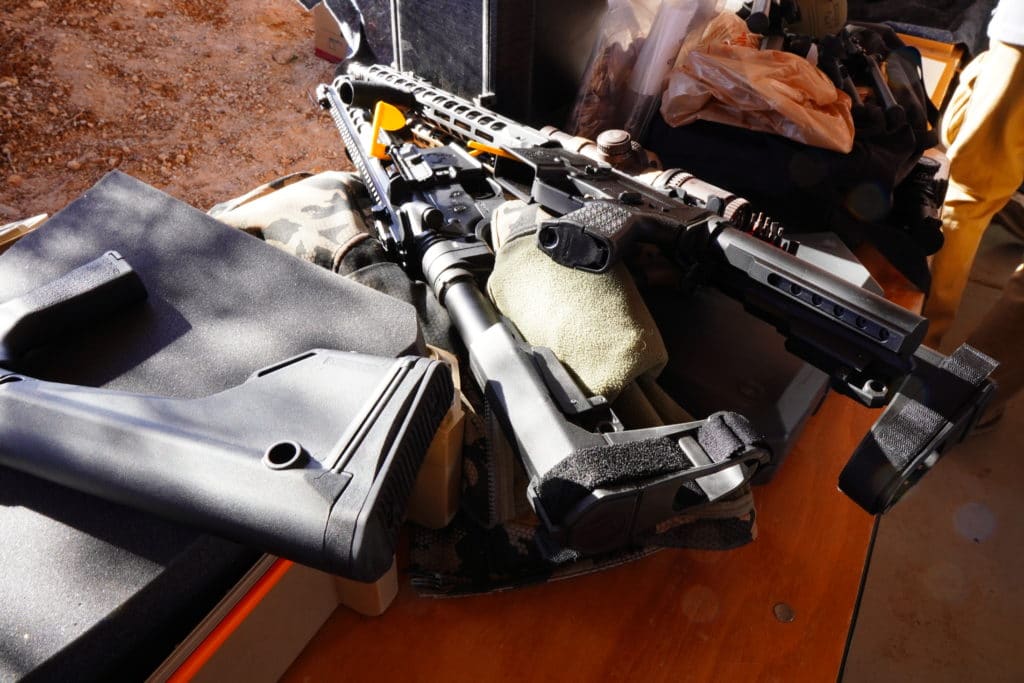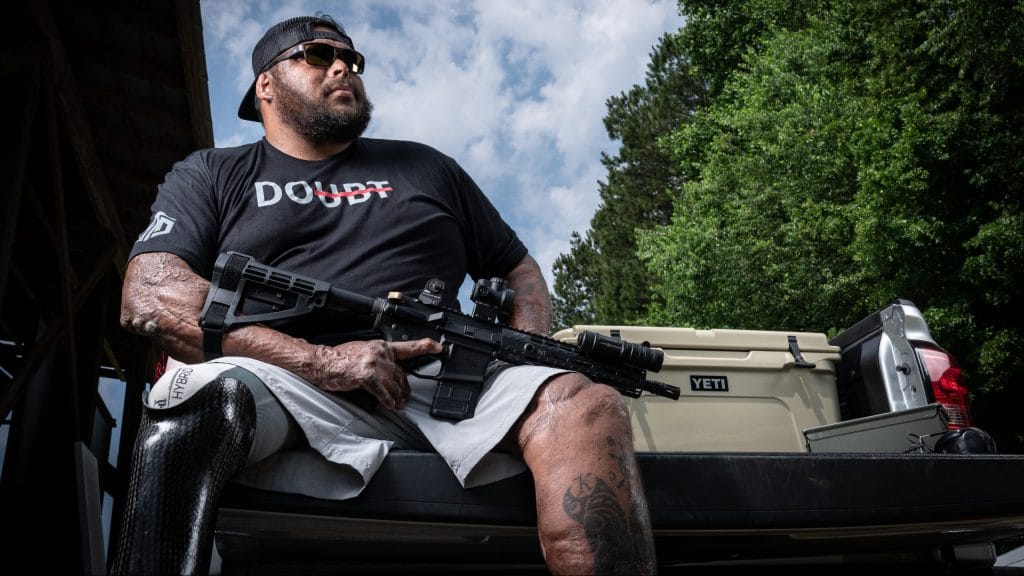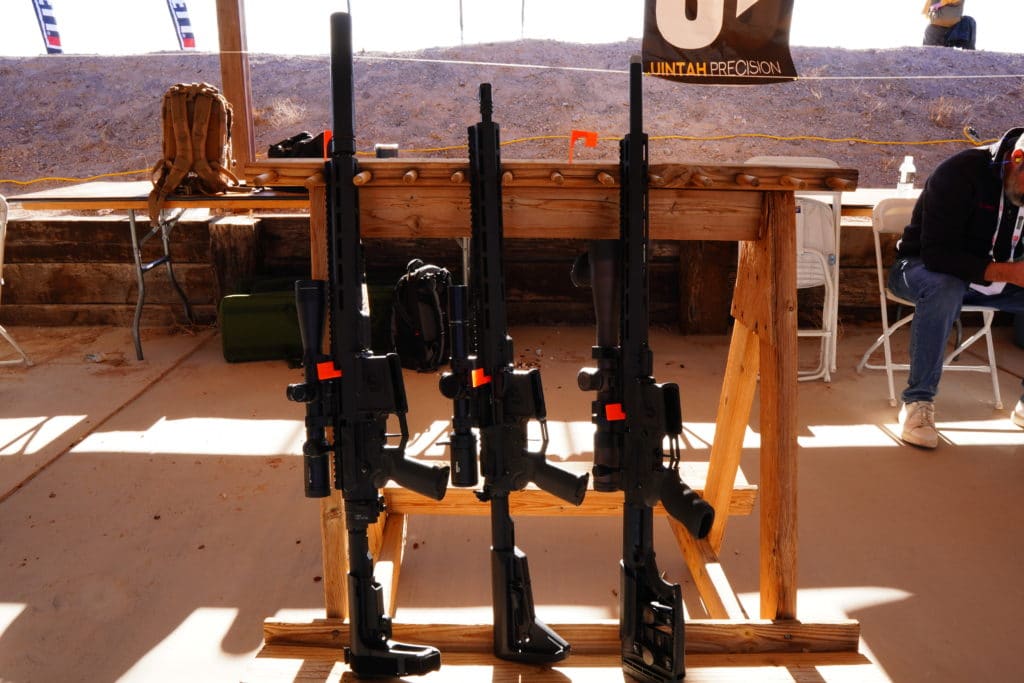The largest gun ban and registration scheme in American history was announced on Friday.
It’s one we’ve known was coming for a long time. But the ATF’s announcement gave us the final details of what the new pistol brace ban, which is expected to impact millions of Americans, will look like in practice. It dumps the convoluted point system for determining whether a braced gun is a short-barrel rifle in the ATF’s eyes and simply says nearly all of them are instead. It also now allows owners to register the guns tax-free.
But anyone who doesn’t do so or otherwise dispose of the guns within 120 days of the rule being published still faces the possibility of federal felony charges and up to a decade in prison. That’s one big reason the courts are unlikely to take the situation lightly. And I explain why that’s bad news for the ATF in light of another recent ruling against them.
Contributing Writer Jake Fogleman examines the new Illinois “assault weapons” ban, and whether it’s the start of a resurgence for the policy.
Plus, I look at the practicality and legality of the new gun insurance mandates with expert RJ Lehmann.
By the way, we had a bug in the site’s caching system earlier in the week that caused the login process to malfunction. We’ve since squashed that bug and things should be operating smoothly now. Thanks to the members who reached out to let us know about the issue!

ATF Bans Millions of Guns With New Pistol Brace Rule
By Stephen Gutowski
Millions of Americans face the threat of federal felony charges over guns they purchased legally thanks to a new rule released by the ATF.
The agency announced plans to publish the final version of their rule reclassifying pistol braces, a popular firearm accessory, on Friday. The rule, which President Joe Biden requested as part of his efforts to unilaterally reform gun laws, would effectively ban the use of braces unless registered with the ATF. Anyone who does not comply with the rule could be subject to upwards of ten years in federal prison despite the agency previously ruling the braces were legal multiple times over the past decade.
“While firearms equipped with ‘stabilizing braces’ or other rearward attachments may be submitted to ATF for a new classification determination, a majority of the existing firearms equipped with a ‘stabilizing brace’ are likely to be classified as ‘rifles’ because they are configured for shoulder fire based on the factors described in this rule,” the ATF said in the rule. “Because many of these firearms generally have a barrel of less than 16 inches, they are likely to be classified as short-barreled rifles subject to regulation and registration under the [National Firearms Act (NFA)] and [Gun Control Act].”
The agency says that nearly everyone with a pistol-brace-equipped gun is “violating the NFA by possessing an unregistered rifle with a barrel of less than 16 inches.”
The rule has wide-ranging implications for many American gun owners as pistol braces have exploded in popularity since the ATF first determined they did not convert pistols into heavily-regulated short-barrel rifles back in 2012. The exact number of braces already in circulation is unclear, but the number is well into the millions. The ATF itself estimates three to seven million of the devices exist. The Congressional Research Service puts the number much higher at somewhere between 10 and 40 million.
The Biden Administration’s decision to move forward with the ban comes after hundreds of thousands of comments opposing the regulation were left during its public comment period. It also comes in the immediate aftermath of the Fifth Circuit ruling against the Trump-era bump stock ban. That policy was implemented through the same rulemaking process and after the ATF had also previously declared bump stocks to fall outside the NFA’s purview, which could foreshadow legal problems for the new pistol brace rule.
Attorney General Merrick Garland (D.) defended the rule change and said it was necessary to prevent crimes committed with guns he believes should be subject to NFA regulations.
“Keeping our communities safe from gun violence is among the Department’s highest priorities,” he said in a statement. “Almost a century ago, Congress determined that short-barreled rifles must be subject to heightened requirements. Today’s rule makes clear that firearm manufacturers, dealers, and individuals cannot evade these important public safety protections simply by adding accessories to pistols that transform them into short-barreled rifles.”
The NFA requires Americans to register all rifles that have barrels shorter than 16 inches and pay a tax of $200, a process that can take nearly a year, or face federal felony charges. However, the law defines “rifles” as guns that are “designed and intended” to be shouldered. The ATF initially determined firearms equipped with pistol braces, which are designed to be strapped to a shooter’s forearm instead of pressed against their shoulder, are not rifles and, therefore, not subject to NFA regulations.
For the next decade, the agency issued often vague or contradictory determinations on different versions of pistol braces that were subsequently created. At one point during the Obama Administration, the agency claimed the act of pressing a pistol brace against a shooter’s shoulder constituted a redesign of the product turning it into an illegal unregistered short-barrel rifle only to later rescind that declaration under the Trump Administration. The inconsistency led to increasing complaints the agency doesn’t use any objective measure for determining the legality of the devices.
Now, under the Biden Administration, the agency’s new rule purports to be more objective but still relies on subjective measures, including whether the agency believes “indirect marketing” of a brace shows it is meant to be shouldered. Ultimately, it classifies nearly all pistol-brace-equipped firearms as unregistered short-barrel rifles. The agency gave Americans who own pistol-braced guns a few options to avoid potential prosecution.
“Any weapons with “stabilizing braces” or similar attachments that constitute rifles under the NFA must be registered no later than 120 days after date of publication in the Federal Register,” the agency said,” or the short barrel removed and a 16-inch or longer rifle barrel attached to the firearm; or permanently remove and dispose of, or alter, the “stabilizing brace” such that it cannot be reattached; or the firearm is turned in to your local ATF office. Or the firearm is destroyed.”
The rule faces substantial political opposition. In addition to the hundreds of thousands of public comments opposing the rule, nearly every member of the Senate Republican caucus sent a letter to Attorney General Garland demanding he withdraw of the rule during the summer.
“The way the proposed rule is written makes clear that ATF intends to bring the most common uses of the most widely possessed stabilizing braces within the purview of the NFA,” the senators said in the letter. “Doing so would turn millions of law-abiding Americans into criminals overnight, and would constitute the largest executive branch-imposed gun registration and confiscation scheme in American history.”
Gun-rights groups have promised to fight the rule in court. Erich Pratt, Gun Owners of America senior vice president, said his group is already writing up a lawsuit.
“This administration continues to find new ways to attack gun owners, and this time their target is brace-equipped firearms that allow persons with disabilities to safely and effectively use pistols,” he said in a statement. “We will continue to work with our industry partners to amplify the disapproving voices in the firearms industry, and the Gun Owners Foundation, our sister legal arm, will be filing suit in the near future.”
Alan Gottlieb, founder of the Second Amendment Foundation, said they will update their active case against the agency over its handling of braces.
“The Second Amendment Foundation already has a lawsuit filed against ATF over arm braces and will amend it to include their new attack,” he told The Reload.

Analysis: Biden’s Pistol Brace Ban Unlikely Survive Scrutiny [Member Exclusive]
By Stephen Gutowski
The ATF is facing an uphill battle after dropping its pistol brace ban.
The agency announced the final version of the ban on Friday. 120 days after it’s published, anyone who hasn’t registered or disposed of their pistol-braced gun could face felony charges. But there’s good reason to think that may never happen, and it came exactly one week before the ATF’s announcement.
On January sixth, the Fifth Circuit ruled against the ATF’s bump stock ban. Despite being passed under two different administrations, the story of the regulations are strikingly similar. As are the glaring legal problems with them.
First off, the ATF’s track record on each device is completely inconsistent. Despite initially saying neither fell under the purview of the National Firearms Act, the agency now claims they do and always did. This creates a tremendous credibility problem for the agency in the public eye and in the courts.
To hear the ATF tell it, firearms equipped with bump stocks were always illegal unregistered machineguns–even when the agency directly said otherwise. Similarly, it now says nearly all guns equipped with pistol braces have always been illegal unregistered short barrel rifles–even when they previously said otherwise.
Even if you ignore those previous determinations, the ATF offers no good explanation for why it allowed the licensed dealers it oversees to sell incredible numbers of guns it now claims were always illegal. This wasn’t done in secret. Nearly every licensed dealer in the country sold pistol-brace-equipped AR-15s, and even the ATF estimates there are at least three million in circulation.
It’s a ruinous position for the agency’s credibility that these guns were always illegal, and it never did anything about it until years later. But they’ve now made that same claim twice. However the credulity of that claim impacts public opinion of the ATF, it has already been rejected by the Fifth Circuit.
That court’s ruling didn’t rely on the recent Bruen standard or even cite the EPA ruling restraining executive agencies’ powers. Instead, it focused on the ATF’s attempt to reinterpret federal law in a way that broadened its own regulatory authority and how confusing the outcome would be for Americans trying to comply with it.
Given the nearly identical development of the bump stock ban and the pistol brace ban (as well as the “ghost gun” kit ban, for that matter), it’s tough to see how they don’t end up at the same destination. The Second Amendment Foundation already has a legal case against the pistol brace ban pending in the Fifth Circuit. Though not a guarantee, it’s entirely possible that a federal judge could block enforcement of the new prohibition before the 120-day grace period ends.
And that’s only possible because of the long fight over the bump stock ban. It took four years–well after the turn-in date for the stocks came and went–for one of the cases against the ban to win at the appellate level. The pistol brace ban could have been subject to the same timetable were it not for the precedent-setting win earlier this month.
Of course, that doesn’t mean the outcome of the legal fight is certain. Little ever is in the courts. The Fifth Circuit ruling against the bump stock ban creates a circuit split that will likely compel the Supreme Court to take up the case if the government decides to appeal, which it almost certainly will.
The High Court just set a high bar for gun laws and regulations to clear in June during the Bruen case. There’s good reason to think it would side with gun owners here too. But there have been dicta and concurrences that suggest at least some members of the majority may not be as gung ho about striking down gun regulations, even if it’s hard to see how they meet the test they’ve agreed to. And the Fifth Circuit’s ruling was focused much more on the limits of executive agency power than Second Amendment rights.
Still, the odds are long enough on the pistol brace ban surviving scrutiny that it’s genuinely surprising the Biden Administration didn’t pause more than a week to reconsider it after the bump stock ban was tossed.
Podcast: The Problems With Gun Insurance Mandates According to Expert RJ Lehmann [Member Early Access]
By Stephen Gutowski
The podcast is back after a holiday and illness break. This week, we’re covering the pair of gun insurance mandates that have recently gone into effect.
R.J. Lehmann, a senior fellow at the International Center for Law and Economics, joins us to discuss the details of New Jersey’s gun-carry insurance mandate and San Jose, California’s gun ownership insurance requirement.
He said the requirements, which are the first of their kind, won’t accomplish the goal lawmakers have claimed. Namely, insurance companies can’t provide coverage for criminal acts. That basically leaves damage caused by accidental shootings as the only real option for coverage.
And even accidental coverage is more limited than most people realize. For instance, homeowners’ insurance–which San Jose now claims qualifies under its mandate–will cover accidental shootings, but only for damages done to third parties. That means any harm caused to the homeowner or family members living in the home wouldn’t be covered.
Lehmann said New Jersey’s requirement is even more problematic because it appears to be trying to require insurance against deliberate, and potentially criminal, acts. He said that’s not something any company offers nor is it a policy lawmakers could realistically force companies to offer. It also goes directly against the state’s complaints about “concealed carry insurance,” which are often not actual insurance policies but lawyer co-ops or group retainer plans.
Beyond the practical problems with the mandates, Lehmann said they also face an uphill battle in the courts. He explains why founding-era surity laws are a bad analogue for these modern requirements and why they are unlikely to survive the Bruen test in the long run.
Plus, Contributing Writer Jake Fogleman and I examine the new Illinois “assault weapons” ban. And Reload Member David Rice tells us about he went from buying his first gun in 2020 to getting involved in gun-rights activism.
You can listen to the show on your favorite podcasting app or by clicking here. Video of the episode is also available on our YouTube channel. As always, Reload Members get access on Sunday, and the episode goes public on Monday.
Come on the Podcast
One of the many perks of a Reload membership is the opportunity to appear on the podcast. We’ve had a lot of people on the show from all kinds of backgrounds. It’s one of my favorite segments since it gives us all a better insight into the community that makes this publication possible. If you want to come on the show, just reply to this email and let me know!

Analysis: State-Level ‘Assault Weapon’ Bans are Back. Is it a Lasting Resurgence, or a Policy in its Death Throes? [Member Exclusive]
By Jake Fogleman
State-level “assault weapon” bans have returned with a bang, achieving new victories in ways not seen in more than two decades. Yet shifts in public opinion and the Supreme Court’s watchful eye mean their days may be numbered.
On Tuesday, Illinois officially became the ninth state in the country to pass a ban on certain semi-automatic firearms commonly referred to by gun-control advocates as assault weapons. The ban, already signed and in effect, outlaws over 170 rifles, pistols, and shotguns by make and model and provides open discretion to the Illinois State Police to add weapons to the prohibited list “as needed.” Owners of the newly-banned guns will be allowed to keep them so long as they possess an active Firearm Owners Identification (FOID) card and register the guns with police.
The ban is significant because it makes Illinois the second state in less than a year to pass a new assault weapon ban—Delaware passed the other last summer. But what’s more significant is that the two laws together represent the first new states to pass bans in more than 20 years.
And more bans may be coming soon.
Outside of Illinois, state lawmakers in Washington state and Colorado have announced proposals for their own statewide assault-weapon bans to be introduced sometime this year. If both are successful, that will represent the largest outbreak of new weapons bans since the 1990s when assault weapon bans were at their political zenith.
California started the trend in 1989, becoming the first state in the country to place a ban on what it considered to be assault weapons. New Jersey followed with a ban of its own a year later. Then, between 1992 and 1998, Hawaii, Connecticut, Maryland, and Massachusetts passed bans of varying stringency (Hawaii and Maryland’s ban dealt with “assault pistols,” for example). Finally, New York rounded out the decade by finalizing its first assault weapon ban in 2000.
Most of these states have subsequently expanded their bans, particularly in the mid-2010s following the Sandy Hook massacre. But until 2022, that was the only serious movement in the country on assault weapon ban legislation. With two new states added to the list, and two more with a real possibility of passing a new ban, it’s undeniable that gun-control advocates have some serious momentum behind them heading into 2023.
At the same time, two significant trends stand to blunt the impact of the gathering momentum behind the burgeoning assault weapon ban push. The first is that the bans are becoming less popular while the weapons they attempt to regulate continue to get more popular.
A June 2022 Quinnipiac University poll conducted in the immediate aftermath of the Uvalde school shooting found that the fewest registered voters supported an assault weapons ban since Quinnipiac first began asking the question in 2013. Just one month later, the same pollster found that support for the ban had dropped yet again, dipping below 50 percent support for the first time ever.
Meanwhile, the revealed preferences of the American public’s gun purchasing habits suggest that so-called assault weapons are more popular than ever. A 2022 estimate from the National Shooting Sports Foundation (NSSF) found that there are at least 24.5 million AR-15s, AK-47s, and their derivatives in civilian hands nationwide. Likewise, the 2021 National Firearms Survey conducted by Georgetown University professor William English found that “30.2% of gun owners, about 24.6 million people, indicated that they have owned an AR-15 or similarly styled rifle.”
The other force that stands to work against this renewed assault weapon push is the U.S. Supreme Court. Its decision in New York State Rifle & Pistol Association v. Bruen and the heightened Second Amendment test it established is undoubtedly the elephant in the room for any ongoing question surrounding the viability of new assault weapon bans.
Two Colorado municipal assault weapon bans have already been blocked under the Bruen test in federal court by judges who ruled that they likely violated the constitution. And the Supreme Court itself has made moves casting doubt on the legality of the bans.
Shortly after issuing its decision in Bruen, the court vacated Federal appeals court rulings upholding Maryland’s assault weapon ban and magazine bans in California and New Jersey. It then ordered the lower courts to rehear those cases with the new Bruen test in mind. It seems unlikely that the court would have decided to go that route if it was inclined to agree with the outcome reached initially in those cases. Bolstering that point is that at least one sitting justice has explicitly called assault weapon bans unconstitutional previously in an official legal opinion as a D.C. Circuit Court judge.
That all makes states deciding now is the prime moment to push for new bans especially confusing. Declines in polling support and increased public ownership of the weapons may not put policymakers off the policy, but the Bruen decision and its implications for mounting a viable legal defense against inevitable legal challenges is a reality that’s more difficult to ignore.
But losing a court case against the new bans may not be much of a deterrent. Politicians always have the option of pointing the finger at the Supreme Court for upending a policy their constituents may still find appealing.
It certainly wouldn’t be the first time such a tactic was employed. Governments in blue cities within red or purple states, such as Philadelphia, routinely pass gun control laws they know to be unconstitutional or illegal under state law. Then, once those laws are invariably struck down, they allow the courts or state legislators to be the foil for why we can’t have nice things.
The Supreme Court may have to step in and offer a definitive ruling on the bans to stop their resurgence, at least in deep blue states. But even that may not be enough.
That’s because, despite the declining public support for assault weapon bans, there are sizeable enough constituencies that support the policy in many places. That’s particularly true in Democratic strongholds like Illinois. So, it’s likely passing new bans without regard for the Supreme Court’s guidance will continue to be popular.
That’s it for now.
I’ll talk to you all again soon.
Thanks,
Stephen Gutowski
Founder
The Reload






